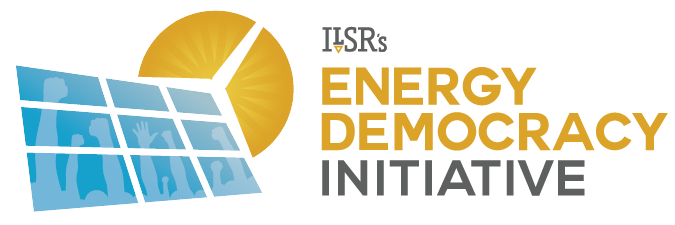A New Logo, And A Definition Of Energy Democracy

Originally published at ilsr.org.
You may have missed our small change, but after rolling out our program logo back in December 2014, we decided to make a small revision in our name and program description, from “democratic energy” to “energy democracy.”
Primarily, this is due to the understandable but mistaken notion that democratic energy had any relationship to the Democratic Party (it doesn’t), but also the growing movement around the term energy democracy.
It’s also an effort to give definition to the term “energy democracy,” a term that has earned a following and a growing commitment among energy activists.
“Energy democracy” implies an energy system that is democratic, where decisions are made by the users of energy. This is the core of the notion of self-reliance, and obviously very close to the heart of our work at the Institute for Local Self-Reliance, where we’ve championed communities having self-determination over a variety of facets of their economy since 1974.
Energy democracy is also being used, with an emphasis on democracy, to describe a system that is equitable in both the management and benefits — in particular, equitable from the standpoint of race and socioeconomic status. ILSR has rarely explicitly stepped into such territory, because our work in shifting of authority into the hands of those most affected by it has tended to be at the 30,000-foot level of local v. state or federal, or public v. private. But it can’t (and shouldn’t) be avoided.
To call a system that decentralizes and disperses the control and economic benefits of the energy system democratic, but without racial and socioeconomic equity, is to cheapen the term democracy.
I wouldn’t presume to define energy democracy for all those using the term, but I think those of us that use it share these common principles:
- Energy democracy means both the sources (e.g. solar panels) and ownership of energy generation are distributed widely.
- Energy democracy means that the management of the energy system be governed by democratic principles (e.g. by a public, transparent, accountable authority) that allows ordinary citizens to have a say. This means that communities that wish greater control over their energy system (via municipalization of utilities, for example) should have minimal barriers to doing so.
- Energy democracy means that the wide distribution of power generation and ownership, and access to governance of the energy system be equitable by race and socioeconomic status.
Hopefully, it’s clear in our work how we hew to these principles of energy democracy. We hope you like our new logo, too.
New Logo
Previous Logo:
For timely updates, follow John Farrell on Twitter or get the Energy Democracy weekly update.

Sign up for CleanTechnica's Weekly Substack for Zach and Scott's in-depth analyses and high level summaries, sign up for our daily newsletter, and follow us on Google News!
Whether you have solar power or not, please complete our latest solar power survey.
Have a tip for CleanTechnica? Want to advertise? Want to suggest a guest for our CleanTech Talk podcast? Contact us here.
Sign up for our daily newsletter for 15 new cleantech stories a day. Or sign up for our weekly one on top stories of the week if daily is too frequent.
CleanTechnica uses affiliate links. See our policy here.
CleanTechnica's Comment Policy


